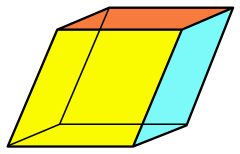Rhombohedron
| Rhombohedron | |
|---|---|

| |
| Type | prism |
| Faces | 6 rhombi |
| Edges | 12 |
| Vertices | 8 |
| Symmetry group | Ci , [2+,2+], (×), order 2 |
| Properties | convex, equilateral, zonohedron, parallelohedron |
In geometry, a rhombohedron (also called a rhombic hexahedron[1][2] or, inaccurately, a rhomboid[a]) is a special case of a parallelepiped in which all six faces are congruent rhombi.[3] It can be used to define the rhombohedral lattice system, a honeycomb with rhombohedral cells. A cube is a special case of a rhombohedron with all sides square.
The rhombohedron has two opposite vertices at which all angles are equal. If this angle us acute then the rhombohedron is long and thin (prolate), if obtuse then it is low and wide (oblate).
Special cases[edit]
 In the table below, is the common angle at the two apices.
In the table below, is the common angle at the two apices.
| Form | Cube | √2 Rhombohedron | Golden Rhombohedron |
|---|---|---|---|
| Angle constraints |
|||
| Ratio of diagonals | 1 | √2 | Golden ratio |
| Occurrence | Regular solid | Dissection of the rhombic dodecahedron | Dissection of the rhombic triacontahedron |
Solid geometry[edit]
For a unit (i.e.: with side length 1) rhombohedron,[4] with rhombic acute angle , with one vertex at the origin (0, 0, 0), and with one edge lying along the x-axis, the three generating vectors are
- e1 :
- e2 :
- e3 :
The other coordinates can be obtained from vector addition[5] of the 3 direction vectors: e1 + e2 , e1 + e3 , e2 + e3 , and e1 + e2 + e3 .
The volume of a rhombohedron, in terms of its side length and its rhombic acute angle , is a simplification of the volume of a parallelepiped, and is given by
We can express the volume another way :
As the area of the (rhombic) base is given by , and as the height of a rhombohedron is given by its volume divided by the area of its base, the height of a rhombohedron in terms of its side length and its rhombic acute angle is given by
Note:
- 3 , where 3 is the third coordinate of e3 .
The body diagonal between the acute-angled vertices is the longest. By rotational symmetry about that diagonal, the other three body diagonals, between the three pairs of opposite obtuse-angled vertices, are all the same length.
Relation to orthocentric tetrahedra[edit]
Four points forming non-adjacent vertices of a rhombohedron necessarily form the four vertices of an orthocentric tetrahedron, and all orthocentric tetrahedra can be formed in this way.[6]
Rhombohedral lattice[edit]
The rhombohedral lattice system has rhombohedral cells, with 6 congruent rhombic faces forming a trigonal trapezohedron[citation needed]:
See also[edit]
Notes[edit]
References[edit]
- ^ Miller, William A. (January 1989). "Maths Resource: Rhombic Dodecahedra Puzzles". Mathematics in School. 18 (1): 18–24. JSTOR 30214564.
- ^ Inchbald, Guy (July 1997). "The Archimedean honeycomb duals". The Mathematical Gazette. 81 (491): 213–219. doi:10.2307/3619198. JSTOR 3619198.
- ^ Coxeter, HSM. Regular Polytopes. Third Edition. Dover. p.26.
- ^ Lines, L (1965). Solid geometry: with chapters on space-lattices, sphere-packs and crystals. Dover Publications.
- ^ "Vector Addition". Wolfram. 17 May 2016. Retrieved 17 May 2016.
- ^ Court, N. A. (October 1934), "Notes on the orthocentric tetrahedron", American Mathematical Monthly, 41 (8): 499–502, doi:10.2307/2300415, JSTOR 2300415.
















